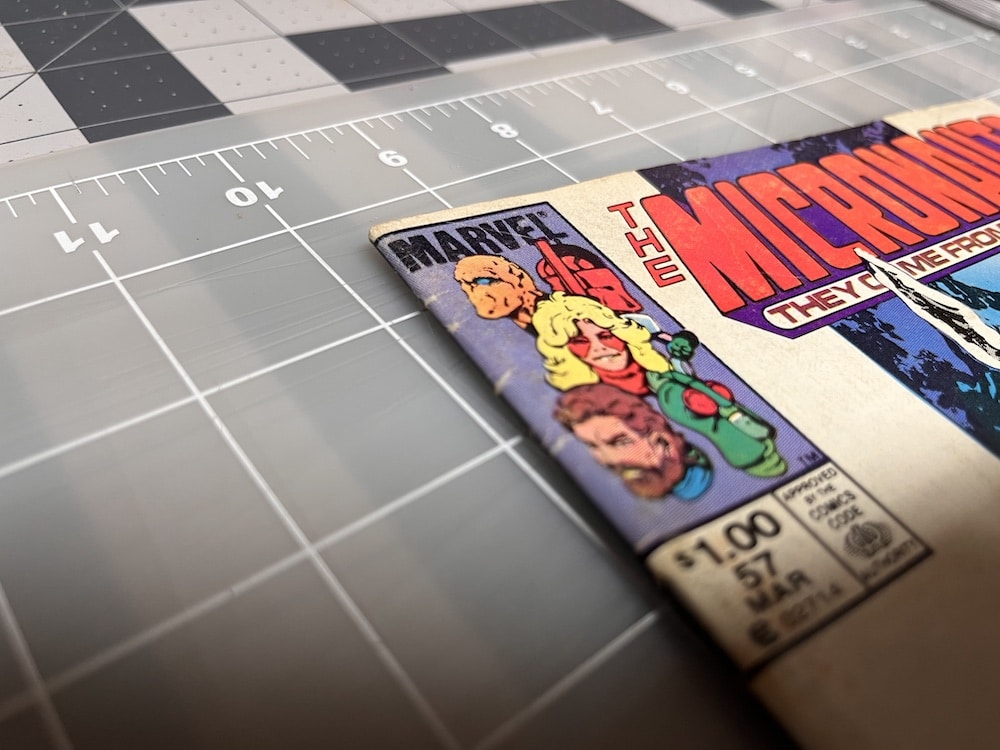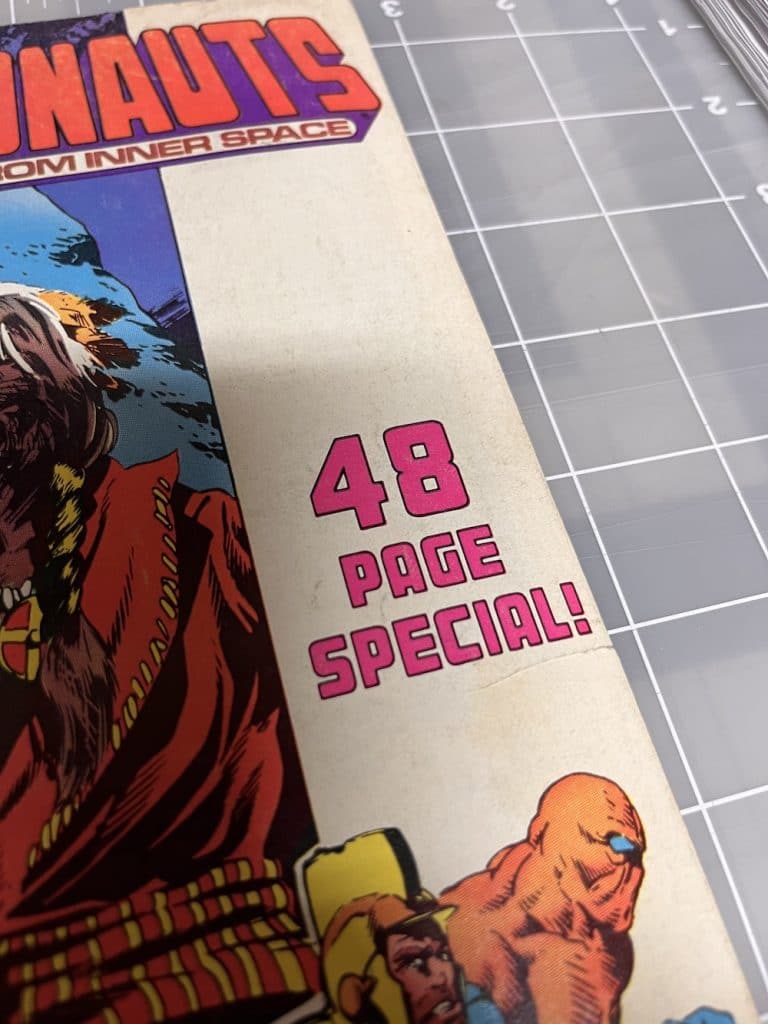A comic book’s condition directly affects its value. Long-time comic book collectors may be familiar with a comic book’s “grade” or terms like fine or mint, or have even seen the professional numerical grade of a comic book that is encased in a plastic slab. But new collectors casual fans are likely to be unfamiliar with the details of grading comics.
So, below is a beginner’s guide to grading comics.
A comic book’s condition directly affects its value.
First, here’s the scale:
- 10.0 Gem Mint (GM)
- 9.9 Mint (M)
- 9.8 Near Mint / Mint (NM / MT)
- 9.6 Near Mint+ (NM+)
- 9.4 Near Mint (NM)
- 9.2 Near Mint- (NM-)
- 9.0 Very Fine / Near Mint (VF / NM)
- 8.5 Very Fine+ (VF+)
- 8.0 Very Fine (VF)
- 7.5 Very Fine– (VF-)
- 7.0 Fine / Very Fine (FN / VF)
- 6.5 Fine+ (FN+)
- 6.0 Fine (FN)
- 5.5 Fine– (FN-)
- 5.0 Very Good / Fine (VG / FN)
- 4.5 Very Good+ (VG+)
- 4.0 Very Good (VG)
- 3.5 Very Good– (VG-)
- 3.0 Good / Very Good (GD / VG)
- 2.5 Good+ (GD+)
- 2.0 Good (GD)
- 1.5 Fair / Good (FR / GD)
- 1.0 Fair (FR)
- 0.5 Poor (PR)
So, the terms are weird, right? I mean, mint? And since when is good worse than fine? If I ask a buddy how he is doing and he says, “fine…” I’m not going to think it’s better than if he says, “Good!”
The above grading scale is the Overstreet Standard and the terms came to be simply because know one really thought assigning a condition grade to comic books would be something anyone at all would care to do.
But coins already had a grading scale back in the day, so why not just borrow from that one? Well, coins are minted, that is, they are minted – or manufactured – out of metal. Comics are printed. But since the scale was taken from coins, comics stole the term mint rather than create a new scale with terms like Perfectly Printed or Perfectly Pressed.
Determining a Grade For Your Comics
A 10.0 is a unicorn, meaning it is a value that is almost never assigned. In fact, most comic buyers will pick up a comic that appears perfectly pristine and walk away thing they have a 9.8 or Near Mint / Mint comic. But, honestly, the majority of comics that are printed come off the racks below Near Mint to begin with. So, if you want a 9.8 from the shop, you need to flip through and examine each one in order to find the very best.
But for simplicity’s sake, let’s walk through how to grade a modern comic book, then we’ll take it a step forward and walk through grading a comic that might be several decades old!
Step 1: Let’s be generous and start by assigning a 9.8 NEAR MINT/MINT to your comic.
Step 2: Count each flaw, no matter how tiny it may seem, like a little tick on the spine or a slightly blunted corner.
Step 3: Each flaw slides the grade down one notch on the grading scale.
For example, you notice your brand new comic has a tiny bend (tick) on the spine. You also notice the upper left corner is a teenie weenie bit blunted. Since we started at 9.8, the tick drops us to 9.6, then the corner drops us to a 9.4 Near Mint grade. And if either of those flaws is signifiant, drop it down two, meaning that’s a 9.2 NM-.
Determining a Grade For Older Comics
Stuff gets real when your comic books older than 2000, particularly if they are older than 1980.
Step 1: Due to general wear and effects of aging, like the yellowing of paper, start by assigning a 9.0 Very Fine / Near Mint (VF / NM). An older comic must have been preserved if there is a hope of a grade higher than this.
Step 2: Count flaws, making a note of how substantial they are and if they are reoccurring.
Step 3: Each flaw slides the grade down one notch on the grading scale.
I consider mid-grade to be 5.0-8.0 and if an older comic looks pretty amazing at first glance, it’s probably a mid-grade comic. Them’s the breaks.
For example, you notice your older comic has ticks on the spine, you are likely dealing with many of them. But if some of them break color (white shows through), then that one flaw might take you two bumps down the scale. And if it is a crease, does the crease run the entire length of the comic or is it just across a corner?
In short, if you find a comic book from 1971 that grades as an 8.0, then you have quite a find on your hands!
Comic Book Flaws Terminology
I’ve used words like ticks and creases, so before we go any further, let’s define some terms.
- Foxing: A bacterial or fungal growth in the paper that appears as yellowish spotting, mainly on older comics.
- Rusty Staple: Most serious when a staple rusts and that rust bleeds onto the surrounding paper.
- Yellowing: A natural yellowing of paper due to age and overexposure to moisture and oxidation. (Comic book collectors use “acid-free” backing boards to help mitigate this yellowing process.)
- Waves: Bends or gentle folds in a comic so that it doesn’t lay flat on a table. Can be fixed by “pressing” a comic.
- Tears: You know what a tear is. So the relevant thing here is how large that split or rip is.
- Spine Tick: A small fold on the spine of the comic. See Color Breaks below.
- Color Breaks: A white line caused by a crease or a tick. A minor flaw won’t “break” the color of the comic book cover, more major ones do.
- Blunted Corners: Dented or dull corners.
- Spine Rolls: When the comic is “rolled” so that the staples are turned up (or down) so they aren’t level / parallel with the cover.
- Dirt: Older comics collect decades worth of schmutz, fingerprints, and general dirt. (Can be cleaned off.)
- Fading: another type of Color Loss that is typically used to describe sun damage or overall reduced color saturation of the entire cover
In order to illustrate the above flaws, let’s grade an old copy of Micronauts. See the pictures below…


Since Micronauts is an older comic, step one is to start at a 9.0, just to account for general wear and yellowing due to age. The blunted corner takes that down to a 8.5 and the general dirtiness takes it down to an 8.0. There is that tear, so we’re at 7.5 now. Foxing drops us to 7.0. The spine ticks drop us to a 6.5, but they are color breaking, so I’m calling it a 6.0.
But what wasn’t shown in the pictures is a slight bend and some wear and creases on the back cover. For that reason, I’d call grade Micronauts a 5.0 Very Good / Fine (VG / FN). Hey, that’s subjective, of course, but I think you get a beginner’s crash course in how you can quickly and easily assign a grade that gets you in the ballpark. If you want an official grade, you have to get the comic slabbed, which I’ll go into below.
Raw and Slabbed Comic Books
Graded Comics are comics that have been professionally certified by a 3rd party company such as CGC and CBCS. Sometimes these comics are referred to as “slabbed” because these companies examine the comics closely, identify flaws, and assign them a grade using the system we’ve been talking about.
They then place them in a sealed protective case that comic collectors often refer to as a “slab.” It will cost you about $25 plus shipping to get your comic graded, but the benefit is that condition is locked in forever and the comic will sell for much more than an uncertified comic.
For modern comics, collectors are chasing those elusive 9.8 grades. But older key issues such as Fantastic Four #1 can fetch thousands upon thousands for even a graded 1.0.
RAW Comics are uncertified comics that have not been verified by a professional grading company. When you buy a comic at your local comic shop (LCS), you buy it “raw,” meaning it’s on you to judge it’s condition.

